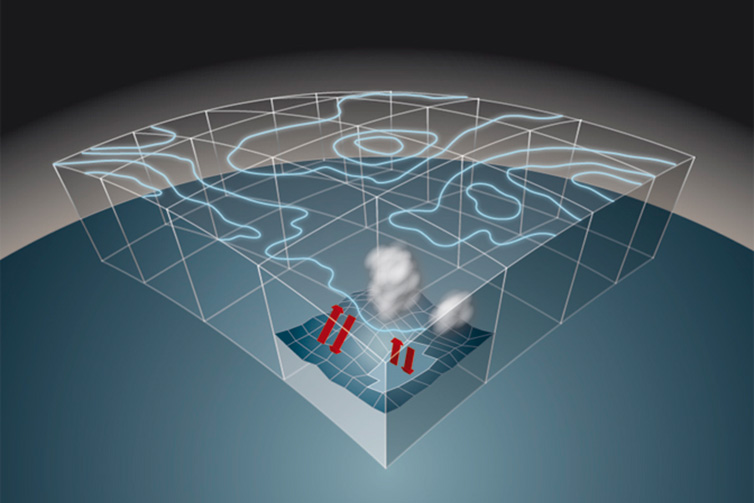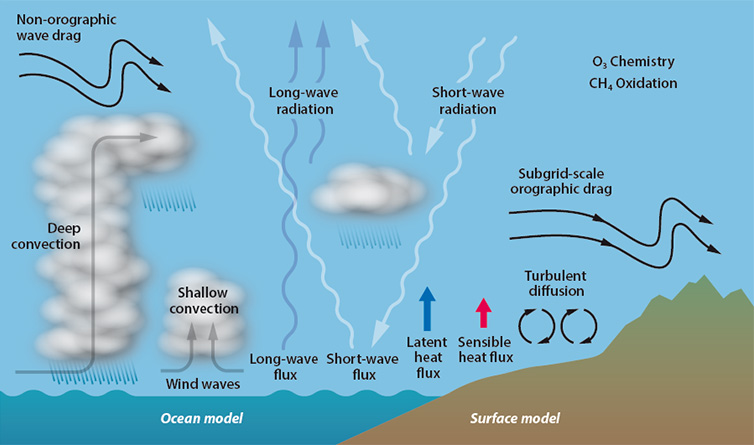

Global weather models divide the atmosphere into millions of grid boxes. They cannot directly capture atmospheric processes that occur at scales smaller than each grid box.
More than 50 scientists will meet at ECMWF from 13 to 16 November to discuss the modelling of atmospheric processes across the globe at ‘grey zone’ resolutions of a few kilometres or less.
Today's global weather models are run with a grid spacing of about 10 to 20 kilometres. This coarse resolution means that some relatively small-scale processes cannot be directly resolved in the models by applying the laws of physics. Instead they have to be simulated separately in so-called parametrization schemes.
Convection, turbulence and drag processes are examples of such subgrid-scale processes that need to be parametrized.
When the grid spacing goes down to the order of a few kilometres, some of these processes become at least in part directly resolved. At these so-called ‘grey zone’ resolutions, a process is not well resolved yet but it is not well represented by existing parametrization schemes either.
At such resolutions, the modelling of the different physical processes and of their interaction needs revisiting. Dedicated scientific exchanges are an excellent way to make progress.

The ocean and the land surface influence a number of processes in the atmosphere, which also interact with each other. The modelling of deep and shallow convection, of turbulence and of their interactions needs to be revisited at grey zone resolutions.
“The grey zone is a hot topic for the Centre as our Strategy calls for global ensemble forecasts at a resolution of 5 km by 2025,” says ECMWF scientist Irina Sandu.
Today at ECMWF, global high-resolution forecasts are run at a resolution of 9 km and ensemble forecasts are run at a resolution of 18 km.
Collaborative approach
The workshop is intended to foster international collaboration on scientific and computational challenges and opportunities that arise when moving into grey zone resolutions at global scale.
“In particular, I think we have a lot to learn about grey zone issues and possible solutions from the limited-area modelling community in our Member and Co-operating States,” Irina says. “They have been producing weather forecasts at these resolutions for more than a decade.”
Collaborative work on different aspects of the grey zone is already under way with a number of national meteorological services, including Météo-France, Germany’s DWD and the UK Met Office.
For example, work has been carried out with UK Met Office colleagues Simon Vosper and Annelize van Niekerk on the representation of drag exerted by orography on atmospheric flow.
This involved performing limited-area simulations of mountain chains of varying complexity, such as South Georgia Island, New Zealand, the Rocky Mountains and the Himalayas, at resolutions ranging from a couple of kilometres to a few tens of kilometres.
The simulations were used to understand how well the transition between resolved and parametrized drag is handled as the resolution increases.
“Part of this work was done in collaboration with ECMWF. It is extremely helpful for understanding whether existing parametrizations are able to simulate the effects of complex mountain chains across a wide range of resolutions,” says Irina.

As the grid spacing ∆x decreases, the contribution of parametrized drag (green) to the total surface drag (blue) decreases, while the contribution of resolved drag (red) increases. Ideally the total drag would be constant across resolutions. In practice this turns out to be the case for some regions but not for others, as in the case of New Zealand shown here. (Figure adapted from Vosper et al., QJRMS, 2016, doi:10.1002/qj.2894)
Interacting processes
The workshop will also explore how best to model interactions between different processes in the grey zone.
How to handle interactions between cloud microphysics, convection and turbulence is of particular interest.
Also of interest is whether the interactions between Earth system components such as the ocean, sea ice, the land surface and the atmosphere need to be reconsidered when performing global simulations at kilometre-scale resolutions.
“A consistent, accurate and efficient interaction between the physical processes and their coupling with the dynamics is essential in order to ensure the correct representation of the different feedbacks controlling the evolution of the atmosphere,” says ECMWF scientist Sylvie Malardel.
Sylvie is co-organising an international workshop on physics-dynamics coupling (PDC18) to take place at the Centre in July next year, where these issues will be explored further.
Livestreaming
The workshop ‘Shedding light on the grey zone’ from 13 to 16 November 2017 will be livestreamed. For more information on the meeting, please visit the workshop page.
